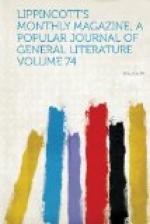A case which has acquired even more celebrity than the last is that of Mrs. Wharton of Baltimore. The chief facts, as developed at the first trial at Annapolis, are as follows: General Ketchum, a man of over middle age and usually in good health, was very much engaged in attending to matters of business at Washington throughout the entire day of the 24th of June, 1871. The weather was very hot, yet he walked about hurriedly and steadily, getting no dinner, and returning in the evening to Mrs. Wharton’s at Baltimore about 9 P.M., where he ate a very hearty meal, consisting partly of raspberries. During the night he was heard to go down stairs several times. The next day he complained of feeling unwell, but took at bed-time a glass of lemonade with brandy, and during the night had some slight vomiting and purging. In the morning he complained of sick stomach and giddiness, and at Mrs. Wharton’s earnest request[16] Dr. Williams was finally sent for, and on arriving at 4 P.M. found him sitting up and vomiting, and prescribed as for a slight attack of cholera morbus. The next morning General Ketchum thought himself so much better that he discharged his physician. He was, however, very drowsy during the day, and the evidence at the trial rendered it probable that he took laudanum on this day upon his own responsibility. In the evening he was found sleeping heavily upon the lounge, and again at Mrs. Wharton’s request Dr. Williams was sent for, but did not think it worth while to come. The next morning Mrs. Wharton again sent for Dr. Williams, as General Ketchum was found still lying upon the lounge in a stupor. He remained in this state until his death, which took place in a convulsion at 3 P.M. He had had during the intervening period repeated convulsions, and about one o’clock had become very uneasy, uttering incoherent cries, but did not recover true consciousness. At the examination of the body, made the following morning, the spinal cord was not looked at: the inner membranes of the brain were found congested, and the brain-substance presented throughout “those dark points of blood which indicate passive congestion.” No other lesions were found, and the stomach was handed for analysis to Professor Aiken, who in due time reported that he had “satisfied himself” of the existence of at least twenty grains of tartar emetic in it.
It is highly probable that this official announcement had much influence upon the minds of Drs. Williams and Chew, with their colleagues, and it is very certain that by it and their representations was created the public belief in Baltimore that General Ketchum had been poisoned. The false analysis remained for months uncontradicted, and backed up as it was by the whole intellectual and moral force of the University of Maryland, it could scarcely happen otherwise than that public opinion should become so set and hardened that no testimony at the trial could affect it, especially as local pride and local prejudice came to its support when experts from other cities questioned the work of the Baltimore physicians.




